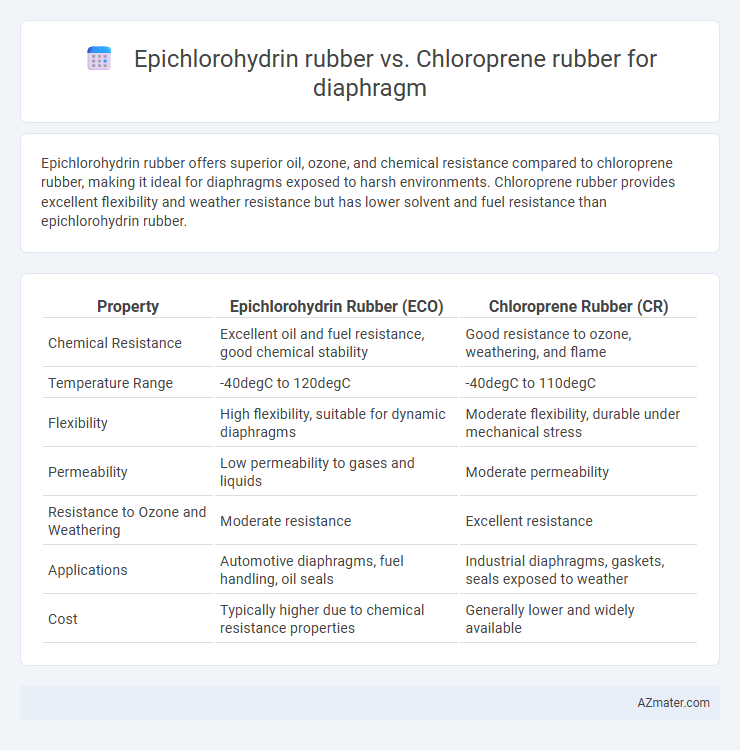Epichlorohydrin rubber offers superior oil, ozone, and chemical resistance compared to chloroprene rubber, making it ideal for diaphragms exposed to harsh environments. Chloroprene rubber provides excellent flexibility and weather resistance but has lower solvent and fuel resistance than epichlorohydrin rubber.
Table of Comparison
| Property | Epichlorohydrin Rubber (ECO) | Chloroprene Rubber (CR) |
|---|---|---|
| Chemical Resistance | Excellent oil and fuel resistance, good chemical stability | Good resistance to ozone, weathering, and flame |
| Temperature Range | -40degC to 120degC | -40degC to 110degC |
| Flexibility | High flexibility, suitable for dynamic diaphragms | Moderate flexibility, durable under mechanical stress |
| Permeability | Low permeability to gases and liquids | Moderate permeability |
| Resistance to Ozone and Weathering | Moderate resistance | Excellent resistance |
| Applications | Automotive diaphragms, fuel handling, oil seals | Industrial diaphragms, gaskets, seals exposed to weather |
| Cost | Typically higher due to chemical resistance properties | Generally lower and widely available |
Introduction to Epichlorohydrin Rubber and Chloroprene Rubber
Epichlorohydrin rubber (ECO) is a synthetic elastomer known for its exceptional resistance to oils, fuels, and ozone, making it ideal for diaphragm applications requiring chemical durability and flexibility. Chloroprene rubber (CR), commonly referred to as neoprene, offers robust resistance to weathering, oxidation, and moderate chemical exposure, providing strength and resilience in diaphragm manufacturing. Both elastomers serve crucial roles in sealing technologies, with ECO preferred for enhanced chemical resistance and CR favored for its balanced mechanical properties and environmental stability.
Chemical Structure and Composition
Epichlorohydrin rubber (ECO) is a copolymer of epichlorohydrin and ethylene oxide, featuring a unique combination of polar and non-polar groups that provide excellent resistance to oils, fuels, and ozone. Chloroprene rubber (neoprene) is a polymer of chloroprene monomers with alternating double bonds, offering balanced resistance to weathering, ozone, and moderate chemical exposure. The ether linkage in epichlorohydrin imparts superior low-temperature flexibility and chemical resistance compared to the polychloroprene's more rigid, saturated backbone, making ECO a preferred choice for diaphragms in aggressive chemical environments.
Key Physical Properties Comparison
Epichlorohydrin rubber offers superior oil, fuel, and ozone resistance with excellent low-temperature flexibility, making it ideal for diaphragms exposed to harsh chemical environments, while chloroprene rubber excels in weathering, ozone, and flame resistance with moderate chemical resistance. Epichlorohydrin typically shows tensile strength around 10-15 MPa and elongation at break 400-600%, compared to chloroprene's tensile strength of 7-12 MPa and elongation between 200-500%. Both rubbers provide good mechanical resilience, but epichlorohydrin's enhanced impermeability to gases and vapors delivers better long-term durability in fuel system diaphragm applications.
Resistance to Fuels, Oils, and Chemicals
Epichlorohydrin rubber demonstrates superior resistance to a wide range of fuels, oils, and chemicals, making it highly suitable for diaphragms exposed to aggressive environments. Chloroprene rubber offers moderate chemical resistance but tends to degrade faster when exposed to aromatic hydrocarbons and strong acids compared to epichlorohydrin. The enhanced fuel and oil resistance of epichlorohydrin rubber extends diaphragm lifespan in applications such as fuel pumps and chemical processing equipment.
Temperature Performance: High and Low Extremes
Epichlorohydrin rubber exhibits superior resistance to low temperatures, maintaining flexibility down to -50degC, making it ideal for diaphragms in cold environments compared to Chloroprene rubber, which typically resists temperatures only down to -40degC. At high temperatures, Chloroprene rubber performs better, withstanding prolonged exposure up to 120degC, whereas Epichlorohydrin has a slightly lower maximum service temperature around 110degC. This temperature performance balance positions Epichlorohydrin rubber for applications with extreme cold, while Chloroprene rubber suits high-temperature diaphragm requirements.
Mechanical Strength and Flexibility
Epichlorohydrin rubber offers superior chemical resistance and balanced mechanical strength with excellent flexibility, making it ideal for diaphragms exposed to oils and weathering. Chloroprene rubber exhibits higher tensile strength and better abrasion resistance, enhancing durability in dynamic applications under moderate mechanical stress. For diaphragms requiring a combination of elongation and resilience, epichlorohydrin provides enhanced flexibility, while chloroprene excels in environments demanding robust mechanical toughness.
Aging, Ozone, and Weathering Resistance
Epichlorohydrin rubber exhibits superior resistance to aging, ozone, and weathering compared to chloroprene rubber, making it highly suitable for diaphragm applications exposed to harsh environmental conditions. Its molecular structure offers enhanced stability against oxidative degradation and UV exposure, which prolongs diaphragm lifespan and maintains elasticity. Chloroprene rubber, while also resistant to ozone and weathering, tends to degrade faster under prolonged aging, resulting in reduced performance in demanding industrial settings.
Cost-Effectiveness and Availability
Epichlorohydrin rubber offers superior chemical resistance and ozone stability, making it cost-effective in applications requiring durability and longevity despite a higher initial price point. Chloroprene rubber, known for its excellent elasticity and moderate chemical resistance, is more widely available and generally less expensive, resulting in lower upfront costs but potentially higher replacement frequency. Evaluating diaphragm applications, epichlorohydrin's enhanced performance often offsets its cost through extended service life, while chloroprene remains a budget-friendly option favored for general-purpose uses.
Typical Applications in Diaphragm Manufacturing
Epichlorohydrin rubber (ECO) offers excellent resistance to oils, fuels, and alkalis, making it ideal for diaphragms used in automotive, chemical processing, and fuel handling systems. Chloroprene rubber (CR), known for its balanced properties including good weather resistance and moderate chemical resistance, is commonly employed in diaphragms for industrial pumps, compressors, and refrigeration equipment. ECO typically outperforms CR in applications requiring high resistance to heat and aggressive chemicals, while CR is preferred for general-purpose diaphragms with exposure to moderate environmental factors.
Selecting the Right Rubber: Epichlorohydrin vs Chloroprene
Epichlorohydrin rubber offers superior resistance to oils, fuels, and ozone, making it ideal for diaphragms exposed to aggressive chemicals and oxidative environments. Chloroprene rubber provides excellent flexibility, weather resistance, and durability, suitable for diaphragms requiring good mechanical properties and outdoor performance. Selecting the right rubber depends on specific application demands such as chemical exposure, temperature range, and mechanical stress to ensure diaphragm longevity and reliability.

Infographic: Epichlorohydrin rubber vs Chloroprene rubber for Diaphragm
 azmater.com
azmater.com